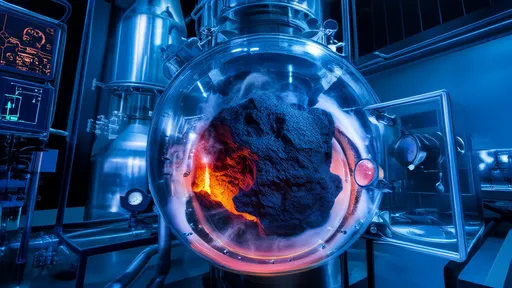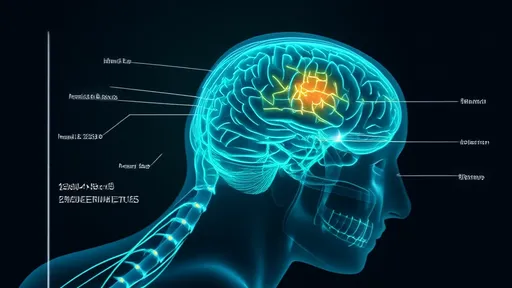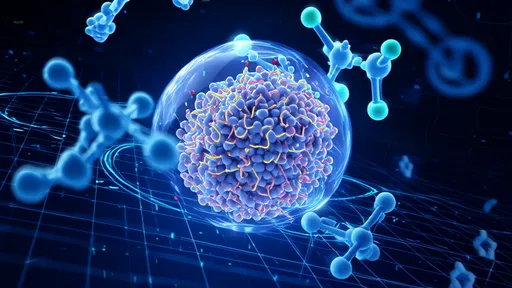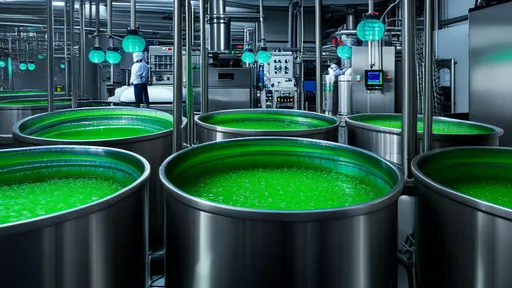For decades, farmers and land reclamation specialists have struggled with the persistent challenge of saline-alkali soils - those unproductive lands where high salt concentrations and alkaline pH levels stunt plant growth and render vast areas agriculturally useless. Traditional remediation methods often proved either too slow, too expensive, or too water-intensive to implement at scale. Now, an innovative electrochemical approach using pulsed electric fields is demonstrating remarkable potential to transform these barren landscapes into fertile ground.
The science behind this technology harnesses precisely controlled electrical pulses to initiate complex electrochemical and physical processes within the soil matrix. When applied to saline-alkali soils, these pulsed electric fields trigger multiple beneficial effects simultaneously. The electrical energy causes salt ions to migrate through the soil profile, effectively redistributing harmful salts away from the root zone. Concurrently, the pulses alter the soil's physical structure, breaking up dense clay formations that contribute to poor drainage and aeration.
Field trials across multiple continents have yielded promising results that exceed conventional expectations. In China's Shandong province, where coastal saline soils have long resisted improvement, test plots treated with pulsed electric field technology showed salt content reductions of 38-62% within just three months. Perhaps more remarkably, the treated soils maintained these improved conditions through subsequent growing seasons without requiring repeat applications - a durability that sets this method apart from temporary fixes like chemical amendments or simple leaching.
The treatment works at molecular and structural levels that conventional methods cannot address. Electrical pulses disrupt the tight bonds between clay particles and sodium ions that characterize sodic soils, allowing for natural drainage to flush away the liberated salts. This process simultaneously improves both the chemical and physical properties of the soil - reducing alkalinity while creating better conditions for root development and microbial activity. The technology appears particularly effective when combined with organic amendments, as the improved soil structure better retains beneficial organic matter.
Economic considerations make this innovation particularly compelling for large-scale implementation. Unlike traditional methods that require massive quantities of water or expensive chemical additives, the pulsed electric field system operates with relatively low energy inputs. Modern solar-powered units have demonstrated the feasibility of off-grid operation in remote areas. The speed of treatment - often showing visible improvement within weeks rather than years - could enable rapid rehabilitation of degraded lands to address food security challenges.
Environmental benefits extend beyond agricultural productivity. Treated soils show increased carbon sequestration potential as plant growth returns, while the reduced need for chemical amendments decreases groundwater contamination risks. The technology may also help address water conservation issues, as it typically requires 30-50% less irrigation water compared to conventional saline soil reclamation methods.
As research continues, scientists are refining pulse parameters (frequency, duration, and intensity) to optimize results for different soil types and salinity levels. Early adopters include government land management agencies and large-scale agricultural operations, but the technology appears scalable for smallholder farmers through cooperative equipment-sharing models. With global saline-alkali soils estimated at over 900 million hectares - an area larger than Brazil - this electrochemical approach could play a crucial role in meeting the world's growing food demands while rehabilitating degraded ecosystems.
The intersection of electrochemistry and agronomy represented by this technology hints at a new frontier in soil science. Rather than working against the fundamental properties of problem soils, pulsed electric fields leverage those properties to drive beneficial transformations. As field validation expands and equipment costs decrease with wider adoption, this innovative approach may redefine what's possible in restoring the world's unproductive lands.
The rhythmic lapping of brackish water against tangled mangrove roots conceals one of nature's most extraordinary genetic survival stories. For centuries, these salt-tolerant trees have guarded molecular secrets in their DNA that allow them to thrive where other plants perish. Today, scientists are cracking open this genetic vault through an ambitious international initiative called the Mangrove Gene Bank Project, with groundbreaking implications for global food security.
In the face of accelerating glacial melt due to climate change, scientists and engineers are turning to innovative solutions to slow the disappearance of these critical ice reserves. One such breakthrough is the development of high-albedo fabric covers, colloquially termed "glacial nanoblankets," designed to reflect sunlight and reduce ice ablation. These advanced textiles are emerging as a promising tool in the fight against rising sea levels and ecosystem disruption.
In the race to mitigate climate change, scientists and engineers are turning to the Earth’s own geological processes for solutions. One of the most promising avenues is basalt carbon mineralization, a natural chemical reaction that locks away carbon dioxide in solid rock. This process, often described as nature’s own carbon capture and storage (CCS) system, is now being harnessed and accelerated to combat rising atmospheric CO₂ levels. Unlike traditional carbon storage methods, which rely on fragile seals and uncertain long-term stability, basalt mineralization offers a permanent and geologically secure solution.
The concept of marine cloud brightening through aerosol seeding has emerged as a potential geoengineering strategy to combat global warming. By enhancing the reflectivity of clouds over oceans, scientists aim to increase Earth's albedo, thereby cooling the planet. This approach, while still in experimental stages, has garnered significant attention due to its promise of offsetting some effects of climate change without requiring drastic reductions in greenhouse gas emissions.
For decades, the study of chronic pain has been hampered by the inability to observe neural activity over extended periods. Traditional imaging techniques provide snapshots of brain activity but fail to capture the dynamic, evolving nature of pain processing. A groundbreaking approach using transparent skull implants is now revolutionizing our understanding of how chronic pain manifests and persists in the brain.
In the perpetual darkness of the deep sea, hydrothermal vents spew superheated, mineral-rich fluids into the frigid water, creating oases of extreme chemistry that have fascinated scientists for decades. These underwater geysers, often located along mid-ocean ridges, host complex reactions that may hold clues to the origins of life and the formation of mineral deposits. Until recently, studying these dynamic systems in their natural state posed immense challenges—until the advent of deep-sea chemical robots capable of in situ monitoring.
In a groundbreaking development that merges cutting-edge physics with ancient archaeology, researchers have successfully utilized neutron holography to reveal hidden inscriptions beneath the patina of bronze artifacts. This non-invasive technique promises to revolutionize the study of corroded metal objects, offering unprecedented access to historical texts without damaging delicate surfaces.
The advent of cryo-electron microscopy (cryo-EM) coupled with artificial intelligence (AI) has revolutionized the field of structural biology. By capturing the intricate dance of proteins in their native states, scientists are now able to unravel the dynamic architectures that govern cellular functions. This powerful synergy between cutting-edge imaging and machine learning is not just a technological leap—it’s a paradigm shift in understanding life at the molecular level.
The world of ultrafast spectroscopy has entered a revolutionary phase with the advent of attosecond spectral knives—a cutting-edge tool that enables scientists to selectively excite specific vibrational states in molecules. This breakthrough technology is reshaping our understanding of molecular dynamics and opening new frontiers in chemical reaction control. Unlike conventional methods that often excite molecules indiscriminately, attosecond spectral knives offer unprecedented precision by targeting individual quantum states with laser pulses lasting mere billionths of a billionth of a second.
The global food system is undergoing a quiet revolution, one fermentation tank at a time. In laboratories and production facilities around the world, scientists and entrepreneurs are harnessing the power of microalgae to create what many believe could become the protein source of the future. These microscopic photosynthetic organisms, grown in controlled fermentation environments, are demonstrating remarkable potential to address some of our most pressing nutritional and environmental challenges.
The agricultural sector is undergoing a quiet revolution as artificial intelligence merges with robotics to address one of nature's most vital processes: pollination. In fields across the world, experimental deployments of mechanical pollinator swarms are demonstrating how AI-driven vision systems can collaborate to mimic—and potentially enhance—the work of vanishing bee populations. These autonomous systems represent not just a technological breakthrough, but a necessary adaptation to ecological instability.
For decades, farmers and land reclamation specialists have struggled with the persistent challenge of saline-alkali soils - those unproductive lands where high salt concentrations and alkaline pH levels stunt plant growth and render vast areas agriculturally useless. Traditional remediation methods often proved either too slow, too expensive, or too water-intensive to implement at scale. Now, an innovative electrochemical approach using pulsed electric fields is demonstrating remarkable potential to transform these barren landscapes into fertile ground.
In the rolling hills of Colombia's coffee belt, a quiet revolution is taking place beneath the emerald canopies of coffee plants. Researchers are conducting groundbreaking field trials with genetically edited coffee plants designed to grow beans naturally low in caffeine. This ambitious project could forever change how the world consumes its most popular psychoactive beverage.
For centuries, the intricate world beneath our feet remained largely a mystery. Farmers, ecologists, and biologists could only speculate about the complex interactions between plant roots and soil structure. Traditional methods of studying root systems involved destructive sampling—digging up plants and washing away soil to examine roots. This approach not only killed the plants but also disrupted the very soil architecture researchers sought to understand. However, a quiet revolution in agricultural science is changing everything.
The concept of piezoelectric railways is revolutionizing the way we think about sustainable energy in transportation. By converting the mechanical energy from train-induced vibrations into electrical power, these systems offer a promising solution for reducing dependency on external power sources. The technology leverages piezoelectric materials, which generate electricity when subjected to mechanical stress, embedding them directly into railway tracks. This innovation not only enhances energy efficiency but also aligns with global efforts to combat climate change by minimizing carbon footprints.














